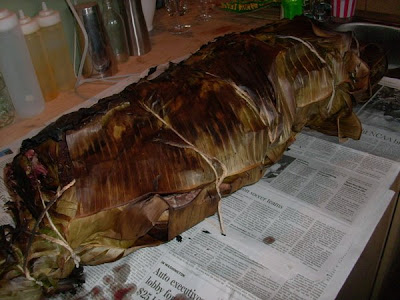
We seasoned it by inserting dozens of whole cloves of garlic into slots we cut all over the animal. We intended to stuff the cavity with lots of fresh rosemary but the store was out of it. Instead, we decided to make a rosemary infused olive oil. I took a cup and a half of olive oil and slowly heated it and an ounce of dried rosemary to about 200 degrees and let it rest for a few hours and strained it. Using a brine pump, we injected the oil into all of the thickest parts of the animal.

We rubbed the whole thing down with salt and pepper and tucked the hind legs up into the body before wrapping it in a single layer of banana leaves. Following my own suggestion from our first pit-roasting experience, we also started with much more coals and burned the pit for three full hours to preheat it.

As you can see, we had 16" or more of coals. We mounded them up on both sides to make room for the lamb. We could smell the banana leave smoking a soon as we placed it in the pit so we quickly covered it with the steel lid and plenty of dirt. It spent a whole 17 hours underground before we unearthed it.


The lamb was cooked beautifully, the garlic and rosemary oil perfumed the lamb nicely and we were happy with the touch of smoke that the burning banana leaves gave the lamb. But it was clear that the pit had dropped below cooking temperature hours earlier. The meat was barely warm when we unwrapped it. We thought that by starting with an animal half the size, with no skin, using less banana leaves and using more coals for a longer time might even result in over-done meat. We now know for sure that it is nearly impossible to over-cook anything using this method. When we build the final version of the pit, we will use much more brick (for more thermal mass) and add a adjustable vent to allow a small amount of air to the bottom of the pit so the coals can be fed and allowed to smolder longer.
We will need a few more experiments and learn a little more about temperature control before we will be ready to cook a 100+ pound hog in the ground but we we do have a much better idea of what the design of the final version of the pit should be.



4 comments:
Re: lamb source. What do you consider local?
Ohio would have been nice. I'm pretty sure Australia is about as far from local as one can get when you live in Ohio. I've been walking past these Halal lambs at Restaurant Depot for years. They look funny sticking out of the bin like baguettes.
Hey Spicehound,
I've tagged you in a blog game. Here are the rules:
1. Link to the person who tagged you.
2. Post the rules on your blog.
3. Write six random things about yourself.
4. Tag six people at the end of your post and link to them.
5. Let each person know they've been tagged and leave a comment on their blog.
6. Let the tagger know when your entry is up.
Thanks!
-Cal
My wife has a Hawaiian friend who's family used to roast pigs a la the banana leaves. Incredible. I've never had lamb that way, but it looks epic.
Check out the WSM if you get the urge next time. I'm pretty sure they have Ohio lamb. Not sure if they raise them from scratch or what, but it could be worth checking out. It's not halal, of course.
Post a Comment